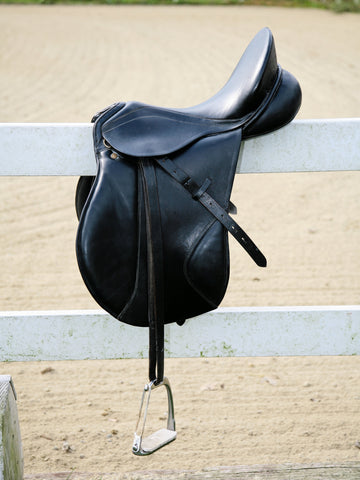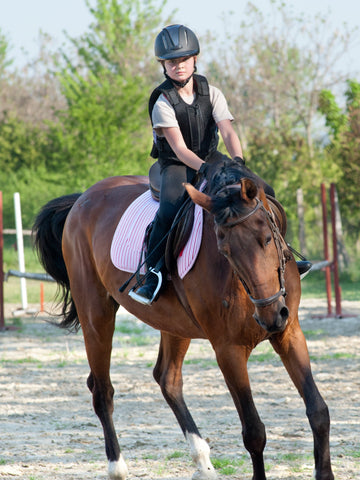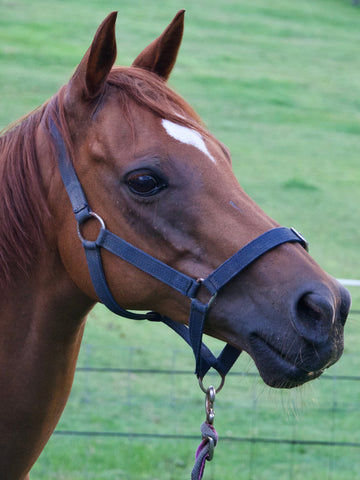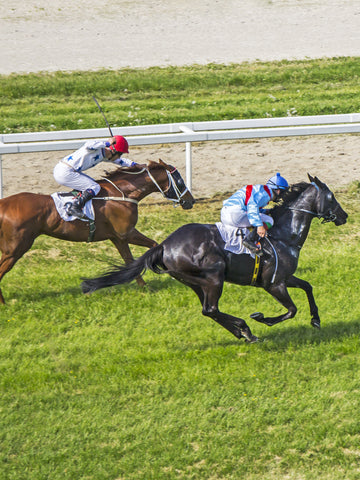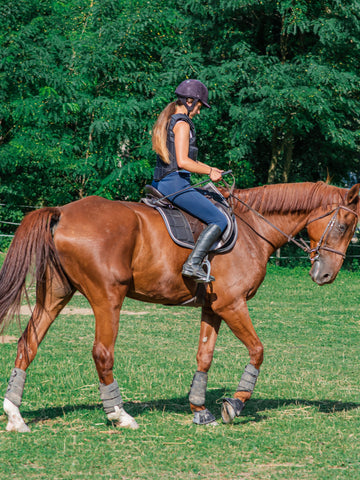A saddle is a kind of seat used for riding horses, camels, donkeys, and other pack animals. And depending on who you ask, there might be three types or thirty types. In the horseracing world, the two main saddle categories are English saddles and Stock saddles. These stock saddles are further classified into American Western Stock and Australian Stock saddles.
You might also see saddles defined as Chinese/Japanese, military, or Asian, with the latter serving riders in East and Central Asia. Then of course you have sub-classes like bareback pads, side saddles, trick saddles, pack-saddles, and even police saddles. The parts of these individual saddles depend on their style, purpose, location, and manufacturing preferences.
This means some saddles have horns while some have dual seating – think of a tandem bike, camel, or elephant. Side saddles were meant to let ladies ride gracefully in their billowing 16th century skirts while trick saddles have extra handholds for bronc riding, bucking, and stunts. Some saddles prioritize weight distribution while others focus on comfort during long trips.
Because these saddles are so diverse, we’re going to focus on English and Stock saddles, naming their most common parts. We’ll also look at the parts that distinguish Australian and American stock saddles. Finally, we’ll touch on concealed under-saddle parts. As a guideline, English saddles are for dressage, polo, etc. while stock saddles are for rodeos and wrangling.
If you’re buying your first saddle, English saddles work better because they’re more versatile and lightweight, so you can use them for multiple riding styles. Stock saddles – whether Western or Australian – are preferred for specific horse riding activities. They’re bulkier so they need more practice and experience. They’re also fussier so they need extra maintenance.
14 Overall Parts of a Saddle
These are the general parts of a saddle, and they cut across all saddle classes regardless of location, function, or classification. Even police saddles and Bedouin saddles have them. But while the parts are the same, their proportions differ. For example, a dressage saddle has straight flaps while a jumping saddle has thicker knee rolls. Roping seats are mostly suede.
This is because the texture of suede gives you a firmer grip. Side saddles have two pommels while racing saddles are flat with extremely short stirrups. Meanwhile, ranching saddles have the thickest horns because the horn doubles as an anchor post when lassoing livestock.
1. Pommel / Fork / Swell

The pommel is the collar-like forked front of the saddle. It rises to support your crotch area, but not quite as high as the cantle. Forks nestle the withers of your horse. (The withers are the ridge between the shoulder blades of a horse, dog, or cow.) As you ride, your body should lean rhythmically into the fork without sliding too far forward. This protects the horse's spine.
2. Seat

This is the center part of the saddle where you sit. It's often padded, though it can be thinner on a bareback pad or a pack saddle. The seat also holds the overhanging parts of the saddle such as the stirrup and the knee pad. It sometimes has a dip in the middle for added comfort.
3. Cantle

The cantle is the ‘opposite’ of the pommel. It’s the back part of the saddle, and it rises as well, and it’s where your nametag goes. Picture it – the seat is the central dip while the pommel is the front ridge and the cantle is the rear ridge, nestling you in the middle. Stock saddles have higher ‘deep seat’ cantles while English saddles opt for have lower ‘close contact’ cantles.
4. Knee Pad / Knee Roll / Knee Block

This is a flap that protects your knee from bumping the horse as you ride. That constant contact can cause friction that will chafe your inner thighs. You can also upset the horse if your knees dig too deep into its flanks. The fender provides protective padding for you both you and the horse. Some saddle styles have thigh pads or thigh rolls in addition to knee pads.
5. Skirt / Jockey

The skirt or jockey is the lowest part of the saddle, the section that comes in direct contact with the horse’s back. It supports the harder upper parts of the saddle like the tree, gullet, and panels, stopping them from digging into your horse’s back. The skirt also helps distribute the weight of all those saddle parts, giving you better balance as you work and ride.
6. Head Nail / Saddle Nail

This small administrative saddle part is often forgotten and rarely labeled. It sits above the skirt and is the clip or fastening that holds all those layers of leather together. You might see another small metal bit labeled as the concho or D-ring. While the saddle nail holds the flaps together, the concho or D-ring lets you attach billets, girth straps, tie straps, and loose strips.
7. D-Ring / Rigging D / Staple / Concho

This metal D-shaped hoop provides an anchor for breastplates, cinches, and other saddle parts. Your saddle generally has multiple D-rings in different sizes and positions. On some saddles, you’ll see conchos instead of D-rings. Conchos are thicker and rounder than D-rings. They're hollow and lined with metal, letting you thread Latigos and straps through them.
8. Twist

If you’re sitting in a horse saddle, you have a cantle behind you, a pommel in front of you, and a ridge between your thighs. That ridge is called the twist, and it affects your stance on the horse and the load on your spine. The twist is narrower on English saddles than Western or Australian ones. A poorly designed or wrongly sized twist could easily damage your core.
9. Panel

The base of every saddle is made of wood, but sitting on that timber would soon leave you too sore to ride. So this wooden frame is covered with padding made of leather, fabric, foam, air, wool, etc. These pieces of padding are called panels or linings. Their style, texture, and thickness depend on the type of saddle. Stock saddles have less cushioning in general.
10. Leather Keeper

When you’re riding a horse, you want to avoid any loose bits of string or buckles that may trip you, snag passing objects, or bother the horse. So little details like keepers are crucial. The keeper is a small leather loop that locks the stirrup strap in place. It allows you to easily adjust the leg length of your stirrup to match your height, weight, and the size of your horse.
11. Flaps / Leathers / Fenders

Fenders, thigh rolls, and knee rolls are often part of the same piece of leather. Their job is to reduce friction and avoid bruising, both on you and the horse. The front part of the flap protects the knee, the middle covers your thighs, and the back is for your legs. These leathers soak up any sweat as you ride, and connect the outer saddle to the structural tree below.
12. Stirrup Iron

Sometimes referred to as a stirrup, this is the metal ‘pedal’ where your foot sits as you ride. They help you stay balanced and support your weight, especially when your rise in your seat to urge the horse forward. Some contemporary stirrups can be plastic, jointed, or spiked.
When using stirrups, proper footwear is essential for both safety and control. Wild Jolie Cowgirl Boots feature the ideal heel design that prevents feet from sliding through stirrups while riding. Their durable construction provides ankle support during long rides, and the traditional western styling complements both stock and English saddles depending on your riding discipline.

A stirrup strap, stirrup leather (on English saddles), or a Latigo leather strap (on stock saddles) attaches the stirrup iron to the rest of the saddle. The stirrup might also have a sliding buckle called a blevin. It clips the stirrup iron onto its strap for quick adjustment.
13. Girth / Cinch

While the saddle sits on the back of a horse, you need a way to keep it from slipping. The most common way is to use a girth or cinch. This wide leather strap passes under your horse’s front legs, connecting the saddle to the body of the horse. Some have a back cinch.
The pommel stops you from slipping forwards, the cantle stops you from sliding backward, and the cinch stops the entire saddle from falling off the horse. While the front girth is a must, the back girth is optional. Cinches are attached with thinner leather straps or thongs.
14. Monkey Grip / Jug Handle / Grab Strap / Croup Strap

To help you mount the horse, some saddles have a handle called a monkey grip. You'll find it at the front of English saddles (aka grab strap) or the side of Australian stock saddles (aka croup strap). American saddles might have one too. It looks like a small handbag strap made of leather, with metal detail. They’re attached to the saddle using D-rings or Latigo keepers.
Apart from helping you get safely onto the horse, these straps can offer extra support when you're making certain horsey maneuvers. For example, you may need a helping hand if you're standing in the stirrups to jump over a fence, whack a polo ball, or lasso some cows.
Extra Parts of an English Saddle
English saddles are flatter and closer to the horse. You’ll see them in equine sports like dressage, show jumping, and Olympic events. They have spring trees made of layered laminated wood and steel springs. Some let you slip your preferred panels underneath.
1. Billet / Girth Strap

English saddles generally use a single cinch. But they can sometimes have two – one at the front and one at the back. But regardless of the number of cinches, you need extra straps to secure it. The girths are wide to distribute weight and avoid hurting the horse’s barrel.
If these strips are too narrow, they could cut into the tummy of the horse. So the girths are secured with thinner leather straps called billets. The billets themselves might loop through a billet keeper. Billets (and their keepers) are the equivalent of the Latigos in stock saddles.
2. Extra Parts of a Stock Saddle

Some have said Australia and America are just teenage versions of Great Britain. After all, they’re louder, more extroverted, keenly rebellious, and they talk funny. So it makes sense that American and Australian (stock) saddles would be bigger and fancier than their conservative, traditional English elders. But their functionality differs too, and that counts.
Generally, English saddles are light and low-fuss, allowing closer intimacy with your horse. Riders are posh, elegant, and affluent. But while the UK is a series of tiny islands, America and Australia are both vast territories with continental spans and massive swathes of land.
So their saddles are heavier, providing comfort during long rides in rugged terrain. American and Australian riders were more likely to be pioneering riders and cowboys, so the emphasis was on toughness and practical comfort rather than minimalism, balance, stability, or grace. Here are some of the parts you might find on a stock saddle that aren’t on English saddles.
3. Horn / Poley

English saddles don’t need horns because you sit low and close on the horse. But for stock saddles, you may need extra support while holding a lasso or bulldogging. A horn is a knob that sits on top of the pommel and you can grab it for extra leverage when you need it. Western saddles always have a horn, while Australian ones have it as an optional part.
4. Latigo / Cinch Strap

English saddles are used for sports and events that focus on horsemanship. They’re about direct partnership with your horse as a sentient being. But stock saddles are more of a tool that allow you to perform ‘cowboy tasks’ like driving cattle or rodeo tricks. So they have extra parts like leather Latigos, saddle strings, and Latigo keepers. Latigos adjust the girth height.
Differences Between English, American, and Australian Saddle Parts

These three types of saddles have similarities in their basic design. But their varying functions mean their parts are slightly varied. As we’ve mentioned, Western and Australian saddles have a horn and a higher cantle for extra support. English saddles are sometimes self-padded because they’re slimmer, so the rider chooses their own cushioning material.
In addition to their flatter profiles, English saddles have a shorter stirrup to keep you closer to the horse. This allows for better control and a more intimate connection with the horse. You can calm, direct, and manage the horse better this way. But Western saddles focus on balance and stability. You need to avoid falling off as you perform tasks like roping or tricks.
Unseen Saddle Parts
When you glance at a saddle, you’ll only see the padded upper section and maybe the leather thongs hanging off the sides. But underneath the gussets and panels, there’s a solid frame. And they influence saddle sizing. So let’s explore the parts of a saddle that hold it together.
Tree

The tree is the basis of most saddles though you can’t see it from the top. Think of it as the foundation or the structural framework of the saddle. Trees are often wooden, but modern ones can be plastic (polyurethane) or fiberglass. And while English saddles have small, narrow ones, stock saddle trees are bigger, with better weight distribution but less padding.
Gullet / Channel

Under the pommel, you’ll find a collar-like tunnel that can be wide, narrow, or adjustable, depending on the size of the horse that will wear it. This tunnel has two ridges that align with the withers of your horse. You can’t see the gullet from the outside, but it’s an important structural tool. Gullets are padded to stop them hurting the horse’s spine and shoulders.
Bonus: Breastplate
This isn’t a standard part of saddles. It’s an optional failsafe for cinches and girths. The breastplate is a leather strap looped through D-rings or conchos. It raps around the neck of the horse and serves as an extra anchor in case the girth or cinch comes loose or breaks off.
How many parts of a saddle can you list in the next ten seconds? Challenge your friends!

